Spatial Synergy Between Carbon Storage and Emissions in Coastal China: Insights from PLUS-InVEST and OPGD Models
Abstract
1. Introduction
2. Materials and Methods
2.1. Study Area
2.2. Dataset
2.2.1. Land Use/Cover
2.2.2. Carbon Density
2.2.3. Carbon Emissions
2.2.4. Driving Factors of Carbon Storage and Carbon Synergy
2.3. Methods
2.3.1. LUCC Patterns in Coastal China During 2000–2020
2.3.2. Multi-Scenario Land-Use/Cover Simulation Using the PLUS Model
- (1)
- Natural development scenario (NDS): Land demand was projected following the land-use trends from 2000 to 2020, using Markov chains. The transition probability matrix retained its original settings, allowing unrestricted conversion of cropland to construction land to simulate spontaneous evolution without policy intervention [34].
- (2)
- Economic development scenario (EDS): Expansion mechanisms for construction land were intensified. Transition probabilities from construction land to other land types were reduced by 40%, while transition probabilities from these land types to construction land were proportionally increased: farmland (40%), woodland (10%), grassland (20%), waters (10%), and unused land (50%).
- (3)
- Ecological protection scenario (EPS): Key ecological areas, including woodland, grassland, and waters, were given stringent protection. Transition probabilities from woodland and grassland to construction land decreased by 20%, while conversions of waters to construction land were reduced by 30%. Ecologically sensitive zones, including protected areas and wetlands, were designated as restricted conversion regions.
- (4)
- Farmland protection scenario (FPS): Give priority to protecting high-quality farmland. Based on the data analysis of 2000–2020, stable farmland with a slope of less than 6° (according to the agricultural land classification agreement) was designated as high-quality farmland and included in the restricted conversion area. Transition probabilities from cropland to construction land decreased by 70%, to grassland/water bodies by 40%, while conversions from unused land to cropland increased by 50%.
2.3.3. Carbon Storage Assessment Using the InVEST Model
2.3.4. Carbon Emission Assessment Based on the Carbon Emission Coefficient Method
2.3.5. Spatiotemporal Trend Analysis of Carbon Storage and Emissions
2.3.6. Identification of Carbon Conflict and Synergy Zones
2.3.7. Driving Mechanisms of Carbon Synergy Based on the OPGD Model
3. Results
3.1. Spatiotemporal Patterns of LUCC During 2000–2020
3.2. Simulation of Land Use/Cover Under Four Scenarios in 2030
3.3. Spatiotemporal Patterns of Carbon Storage from 2000 to 2030
3.4. Spatiotemporal Trend of Carbon Storage and Emissions
3.5. The Conflict and Synergy Between Carbon Storage and Emissions
3.6. The Driving Mechanism of Carbon Storage–Emission Synergy in 2020
4. Discussion
4.1. Advantage of the PLUS-InVEST Model in Assessing Carbon Storage
4.2. Impacts of Human Activities, Policies, and Coastal Saltwater Intrusion on Carbon Storage Dynamics
4.3. The Synergy and Conflict Between Carbon Storage and Carbon Emissions
4.4. The Driving Mechanism of Carbon Synergy Using the OPGD Model
4.5. Limitations and Future Perspectives
5. Conclusions
- (1)
- Coastal China experienced significant LUCC from 2000 to 2020, characterized by rapid urbanization-driven farmland loss and construction land expansion. This transition led to a net decline in carbon storage, primarily due to soil organic carbon depletion and biomass loss.
- (2)
- Land-use scenarios that prioritize ecological and farmland protection had greater potential for enhancing carbon storage by 2030, highlighting the critical role of policy-driven land management in shaping future carbon dynamics.
- (3)
- Carbon synergy zones are concentrated in forests and sparsely populated areas, while conflict zones are concentrated in urban agglomerations. Under EDS and NDS, the conflict areas have expanded significantly; under EPS and FPS, the synergy zones have significantly expanded.
- (4)
- Carbon synergy was predominantly influenced by the interaction of socioeconomic (population density and nighttime light index) and natural factors (mean annual temperature, mean annual precipitation, and elevation), emphasizing the need for integrated land–climate policy frameworks.
- (5)
- Future research should fully consider the dynamic changes in carbon density and carbon emission coefficients over time and in response to the growth status of vegetation. At the same time, attention should be paid to the issue of uncertainty propagation in land-use and carbon prediction models. Moreover, the PLUS-Invest-OPGD framework should be extended and applied to global coastal areas to reveal the multi-scale spatial patterns of carbon synergy and conflict. These efforts will significantly enhance the scientific basis and policy guidance value of climate mitigation strategies based on land in the context of global climate change.
Supplementary Materials
Author Contributions
Funding
Data Availability Statement
Conflicts of Interest
References
- Hu, C.; Wang, Z.; Wang, Y.; Sun, D.; Zhang, J. Combining MSPA-MCR Model to Evaluate the Ecological Network in Wuhan, China. Land 2022, 11, 213. [Google Scholar] [CrossRef]
- Zhu, E.; Qi, Q.; Chen, L.; Wu, X. The Spatial-Temporal Patterns and Multiple Driving Mechanisms of Carbon Emissions in the Process of Urbanization: A Case Study in Zhejiang, China. J. Clean. Prod. 2022, 358, 131954. [Google Scholar] [CrossRef]
- Zhong, R.; Pu, L.; Xie, J.; Yao, J.; Qie, L.; He, G.; Wang, X.; Zhang, R.; Zhai, J.; Gong, Z.; et al. Carbon Storage in Typical Ecosystems of Coastal Wetlands in Jiangsu, China: Spatiotemporal Patterns and Mechanisms. CATENA 2025, 254, 108882. [Google Scholar] [CrossRef]
- Wang, H.; Guo, J. Research on the Impact Mechanism of Multiple Environmental Regulations on Carbon Emissions under the Perspective of Carbon Peaking Pressure: A Case Study of China’s Coastal Regions. Ocean. Coast. Manag. 2024, 249, 106985. [Google Scholar] [CrossRef]
- Xu, S.; Zhang, S.; Pan, Y.; Liu, X.; Welsch, E.; Ma, X.; Guo, C.; Dai, H. Health Equity and Synergistic Abatement Strategies of Carbon Dioxide and Air Pollutant Emissions Reduction in China’s Eastern Coastal Area. Environ. Res. Lett. 2024, 19, 104023. [Google Scholar] [CrossRef]
- Tang, X.; Zhao, X.; Bai, Y.; Tang, Z.; Wang, W.; Zhao, Y.; Wan, H.; Xie, Z.; Shi, X.; Wu, B.; et al. Carbon Pools in China’s Terrestrial Ecosystems: New Estimates Based on an Intensive Field Survey. Proc. Natl. Acad. Sci. USA 2018, 115, 4021–4026. [Google Scholar] [CrossRef]
- Yang, K.; Zhou, P.; Wu, J.; Yao, Q.; Yang, Z.; Wang, X.; Wen, Y. Carbon Stock Inversion Study of a Carbon Peaking Pilot Urban Combining Machine Learning and Landsat Images. Ecol. Indic. 2024, 159, 111657. [Google Scholar] [CrossRef]
- Li, P.; Chen, J.; Li, Y.; Wu, W. Using the InVEST-PLUS Model to Predict and Analyze the Pattern of Ecosystem Carbon Storage in Liaoning Province, China. Remote Sens. 2023, 15, 4050. [Google Scholar] [CrossRef]
- Li, C.; Xu, H.; Du, P.; Tang, F. Predicting Land Cover Changes and Carbon Stock Fluctuations in Fuzhou, China: A Deep Learning and InVEST Approach. Ecol. Indic. 2024, 167, 112658. [Google Scholar] [CrossRef]
- Li, C.; Wu, Y.; Gao, B.; Zheng, K.; Wu, Y.; Li, C. Multi-Scenario Simulation of Ecosystem Service Value for Optimization of Land Use in the Sichuan-Yunnan Ecological Barrier, China. Ecol. Indic. 2021, 132, 108328. [Google Scholar] [CrossRef]
- Wei, Q.; Abudureheman, M.; Halike, A.; Yao, K.; Yao, L.; Tang, H.; Tuheti, B. Temporal and Spatial Variation Analysis of Habitat Quality on the PLUS-InVEST Model for Ebinur Lake Basin, China. Ecol. Indic. 2022, 145, 109632. [Google Scholar] [CrossRef]
- Xiong, L.; Wang, M.; Mao, J.; Huang, B. A Review of Building Carbon Emission Accounting Methods under Low-Carbon Building Background. Buildings 2024, 14, 777. [Google Scholar] [CrossRef]
- Wang, J.; Li, X.; Christakos, G.; Liao, Y.; Zhang, T.; Gu, X.; Zheng, X. Geographical Detectors-Based Health Risk Assessment and Its Application in the Neural Tube Defects Study of the Heshun Region, China. Int. J. Geogr. Inf. Sci. 2010, 24, 107–127. [Google Scholar] [CrossRef]
- Song, Y.; Wang, J.; Ge, Y.; Xu, C. An Optimal Parameters-Based Geographical Detector Model Enhances Geographic Characteristics of Explanatory Variables for Spatial Heterogeneity Analysis: Cases with Different Types of Spatial Data. GISci. Remote Sens. 2020, 57, 593–610. [Google Scholar] [CrossRef]
- Zheng, Z.; Wu, Z.; Chen, Y.; Yang, Z.; Marinello, F. Exploration of Eco-Environment and Urbanization Changes in Coastal Zones: A Case Study in China over the Past 20 Years. Ecol. Indic. 2020, 119, 106847. [Google Scholar] [CrossRef]
- GB/T 21010-2017; Current Land Use Classification. General Administration of Quality Supervision, Inspection and Quarantine of the People’s Republic of China, Standardization Administration of the People’s Republic of China: Beijing, China, 2017.
- Xu, X.; Li, D.; Liu, H.; Zhao, G.; Cui, B.; Yi, Y.; Yang, W.; Du, J. Comparative Validation and Misclassification Diagnosis of 30-Meter Land Cover Datasets in China. Remote Sens. 2024, 16, 4330. [Google Scholar] [CrossRef]
- Jiang, H.; Cui, Z.; Fan, T.; Yin, H. Impacts of Land Use Change on Carbon Storage in the Guangxi Beibu Gulf Economic Zone Based on the PLUS-InVEST Model. Sci. Rep. 2025, 15, 6468. [Google Scholar] [CrossRef]
- Lei, J.; Zhang, L.; Chen, Z.; Wu, T.; Chen, X.; Li, Y. The Impact of Land Use Change on Carbon Storage and Multi-Scenario Prediction in Hainan Island Using InVEST and CA-Markov Models. Front. For. Glob. Change 2024, 7, 1349057. [Google Scholar] [CrossRef]
- Wu, W.; Huang, Z.; Sun, Z.; Zhang, J.; Wang, S.; Fang, M.; Yang, H.; Lu, H.; Guo, G.; Liu, W. Simulation and Attribution Analysis of Terrestrial Ecosystem Carbon Storage of Hainan Island from 2015 to 2050. Sci. Total Environ. 2024, 917, 170348. [Google Scholar] [CrossRef]
- Wang, W.; Hu, Y.; Mao, X.; Zhang, Y.; Tang, L.; Cai, J. Terrestrial Carbon Storage Estimation in Guangdong Province (2000–2021). Data 2025, 10, 41. [Google Scholar] [CrossRef]
- Nie, Q.; Man, W.; Li, Z.; Wu, X. From Policy to Practice: Assessing Carbon Storage in Fujian Province Using Patch-Generating Land Use Simulation and Integrated Valuation of Ecosystem Services and Tradeoffs Models. Land 2025, 14, 179. [Google Scholar] [CrossRef]
- Zhang, X.; Wang, J.; Yue, C.; Ma, S.; Wang, L.-J. Exploring the Spatiotemporal Changes in Carbon Storage under Different Development Scenarios in Jiangsu Province, China. PeerJ 2022, 10, e13411. [Google Scholar] [CrossRef] [PubMed]
- Wang, Y.; Jiang, X.; Gao, S.; Jiang, Q.; Du, H.; Han, N. Multi-Scenario Carbon Storage Analysis Based on PLUS Model and InVEST Model: A Case Study of Zhejiang Province, China. Earth Sci. Inform. 2025, 18, 192. [Google Scholar] [CrossRef]
- Zheng, H.; Zheng, H. Assessment and Prediction of Carbon Storage Based on Land Use/Land Cover Dynamics in the Coastal Area of Shandong Province. Ecol. Indic. 2023, 153, 110474. [Google Scholar] [CrossRef]
- He, Y.; Xia, C.; Shao, Z.; Zhao, J. The Spatiotemporal Evolution and Prediction of Carbon Storage: A Case Study of Urban Agglomeration in China’s Beijing-Tianjin-Hebei Region. Land 2022, 11, 858. [Google Scholar] [CrossRef]
- Rong, T.; Zhang, P.; Zhu, H.; Jiang, L.; Li, Y.; Liu, Z. Spatial Correlation Evolution and Prediction Scenario of Land Use Carbon Emissions in China. Ecol. Inform. 2022, 71, 101802. [Google Scholar] [CrossRef]
- IPCC. 2019 Refinement to the 2006 IPCC Guidelines for National Greenhouse gas Inventory. Agric. For. Other Land Use 2019, 4, 824. [Google Scholar]
- Hu, C.; Wang, Z.; Huang, G.; Ding, Y. Construction, Evaluation, and Optimization of a Regional Ecological Security Pattern Based on MSPA–Circuit Theory Approach. Int. J. Environ. Res. Public. Health 2022, 19, 16184. [Google Scholar] [CrossRef]
- Liu, X.; Andersson, C. Assessing the Impact of Temporal Dynamics on Land-Use Change Modeling. Comput. Environ. Urban Syst. 2004, 28, 107–124. [Google Scholar] [CrossRef]
- Guo, R.; Wu, T.; Wu, X.; Luigi, S.; Wang, Y. Simulation of Urban Land Expansion Under Ecological Constraints in Harbin-Changchun Urban Agglomeration, China. Chin. Geogr. Sci. 2022, 32, 438–455. [Google Scholar] [CrossRef]
- Liang, X.; Guan, Q.; Clarke, K.C.; Liu, S.; Wang, B.; Yao, Y. Understanding the Drivers of Sustainable Land Expansion Using a Patch-Generating Land Use Simulation (PLUS) Model: A Case Study in Wuhan, China. Comput. Environ. Urban Syst. 2021, 85, 101569. [Google Scholar] [CrossRef]
- Tang, W.; Hu, J.; Zhang, H.; Wu, P.; He, H. Kappa Coefficient: A Popular Measure of Rater Agreement. Shanghai Arch. Psychiatry 2015, 27, 62–67. [Google Scholar] [CrossRef] [PubMed]
- Nie, W.; Xu, B.; Yang, F.; Shi, Y.; Liu, B.; Wu, R.; Lin, W.; Pei, H.; Bao, Z. Simulating Future Land Use by Coupling Ecological Security Patterns and Multiple Scenarios. Sci. Total Environ. 2023, 859, 160262. [Google Scholar] [CrossRef] [PubMed]
- Zafar, Z.; Zubair, M.; Zha, Y.; Mehmood, M.S.; Rehman, A.; Fahd, S.; Nadeem, A.A. Predictive Modeling of Regional Carbon Storage Dynamics in Response to Land Use/Land Cover Changes: An InVEST-Based Analysis. Ecol. Inform. 2024, 82, 102701. [Google Scholar] [CrossRef]
- Alam, S.A.; Starr, M.; Clark, B.J.F. Tree Biomass and Soil Organic Carbon Densities across the Sudanese Woodland Savannah: A Regional Carbon Sequestration Study. J. Arid. Environ. 2013, 89, 67–76. [Google Scholar] [CrossRef]
- He, Y.; Ma, J.; Zhang, C.; Yang, H. Spatio-Temporal Evolution and Prediction of Carbon Storage in Guilin Based on FLUS and InVEST Models. Remote Sens. 2023, 15, 1445. [Google Scholar] [CrossRef]
- Anselin, L. Local Indicators of Spatial Association—LISA. Geogr. Anal. 1995, 27, 93–115. [Google Scholar] [CrossRef]
- Tian, S.; Wang, S.; Bai, X.; Luo, G.; Li, Q.; Yang, Y.; Hu, Z.; Li, C.; Deng, Y. Global Patterns and Changes of Carbon Emissions from Land Use during 1992–2015. Environ. Sci. Ecotechnology 2021, 7, 100108. [Google Scholar] [CrossRef]
- Hubau, W.; Lewis, S.L.; Phillips, O.L.; Affum-Baffoe, K.; Beeckman, H.; Cuní-Sanchez, A.; Daniels, A.K.; Ewango, C.E.N.; Fauset, S.; Mukinzi, J.M.; et al. Asynchronous Carbon Sink Saturation in African and Amazonian Tropical Forests. Nature 2020, 579, 80–87. [Google Scholar] [CrossRef]
- Yang, S.; Yang, X.; Gao, X.; Zhang, J. Spatial and Temporal Distribution Characteristics of Carbon Emissions and Their Drivers in Shrinking Cities in China: Empirical Evidence Based on the NPP/VIIRS Nighttime Lighting Index. J. Environ. Manage. 2022, 322, 116082. [Google Scholar] [CrossRef]
- Zhao, S.; Zhou, D.; Wang, D.; Chen, J.; Gao, Y.; Zhang, J.; Jiang, J. Ecosystem Carbon Storage Assessment and Multi-Scenario Prediction in the Weihe River Basin Based on PLUS-InVEST Model. Chin. J. Appl. Ecol. 2024, 35, 2044–2054. [Google Scholar] [CrossRef]
- Fu, S.; Zhen, Z.; Zhou, H.; Wang, B.; Qiao, Q. Spatio-Temporal Evolution and Prediction of Carbon Storage at the Source of the Fen River and Sanggan River Based on a PLUS-InVEST Model. Front. Environ. Sci. 2024, 12, 1449576. [Google Scholar] [CrossRef]
- Li, J.; Hu, J.; Kang, J.; Shu, W. Spatio-Temporal Variation and Prediction of Land Use and Carbon Storage Based on PLUS-InVEST Model in Shanxi Province, China. Landsc. Ecol. Eng. 2025, 21, 107–119. [Google Scholar] [CrossRef]
- Li, Y.; Yao, S.; Jiang, H.; Wang, H.; Ran, Q.; Gao, X.; Ding, X.; Ge, D. Spatial-Temporal Evolution and Prediction of Carbon Storage: An Integrated Framework Based on the MOP–PLUS–InVEST Model and an Applied Case Study in Hangzhou, East China. Land 2022, 11, 2213. [Google Scholar] [CrossRef]
- Zhang, Y.; Liao, X.; Sun, D. A Coupled InVEST-PLUS Model for the Spatiotemporal Evolution of Ecosystem Carbon Storage and Multi-Scenario Prediction Analysis. Land 2024, 13, 509. [Google Scholar] [CrossRef]
- Guo, W.; Teng, Y.; Li, J.; Yan, Y.; Zhao, C.; Li, Y.; Li, X. A New Assessment Framework to Forecast Land Use and Carbon Storage under Different SSP-RCP Scenarios in China. Sci. Total Environ. 2024, 912, 169088. [Google Scholar] [CrossRef]
- Wang, Q.; Zhang, W.; Xia, J.; Ou, D.; Tian, Z.; Gao, X. Multi-Scenario Simulation of Land-Use/Land-Cover Changes and Carbon Storage Prediction Coupled with the SD-PLUS-InVEST Model: A Case Study of the Tuojiang River Basin, China. Land 2024, 13, 1518. [Google Scholar] [CrossRef]
- Yuan, H.; Zhang, J.; Wang, Z.; Qian, Z.; Wang, X.; Xu, W.; Zhang, H. Multi-Temporal Change of LULC and Its Impact on Carbon Storage in Jiangsu Coastal, China. Land 2023, 12, 1943. [Google Scholar] [CrossRef]
- Zhao, L.; Gao, H.; Liu, J.; Wang, F.; Fu, T. Modeling, Assessment, and Prediction of Carbon Storage in Hebei–Tianjin Coastal Wetlands. Remote Sens. 2024, 16, 4428. [Google Scholar] [CrossRef]
- Pyles, M.V.; Magnago, L.F.S.; Maia, V.A.; Pinho, B.X.; Pitta, G.; de Gasper, A.L.; Vibrans, A.C.; dos Santos, R.M.; van den Berg, E.; Lima, R.A.F. Human Impacts as the Main Driver of Tropical Forest Carbon. Sci. Adv. 2022, 8, eabl7968. [Google Scholar] [CrossRef]
- Wei, B.; Mollenhauer, G.; Kusch, S.; Hefter, J.; Grotheer, H.; Schefuß, E.; Geibert, W.; Ransby, D.; Jia, G. Anthropogenic Perturbations Change the Quality and Quantity of Terrestrial Carbon Flux to the Coastal Ocean. J. Geophys. Res. Biogeosciences 2023, 128, e2023JG007482. [Google Scholar] [CrossRef]
- Guild, R.; Wang, X.; Quijón, P.A. Climate Change Impacts on Coastal Ecosystems. Environ. Res. Clim. 2025, 3, 042006. [Google Scholar] [CrossRef]
- Lopes, C.L.; Sousa, M.; Picado, A.; Dias, J.M. Climate Change Challenges on Coastal Environments: Physical Processes in Upwelling and Estuarine Systems. In Zooplankton Challenges in a Changing World; CRC Press: Boca Raton, FL, USA, 2025; ISBN 978-1-032-66227-5. [Google Scholar]
- Zhang, L.; Guan, Q.; Li, H.; Chen, J.; Meng, T.; Zhou, X. Assessment of Coastal Carbon Storage and Analysis of Its Driving Factors: A Case Study of Jiaozhou Bay, China. Land 2024, 13, 1208. [Google Scholar] [CrossRef]
- Watanabe, K.; Tokoro, T.; Moki, H.; Kuwae, T. Contribution of Marine Macrophytes to pCO2 and DOC Variations in Human-Impacted Coastal Waters. Biogeochemistry 2024, 167, 831–848. [Google Scholar] [CrossRef]
- Fan, J.-L.; Zhou, W.; Ding, Z.; Zhang, X. The Substantial Impacts of Carbon Capture and Storage Technology Policies on Climate Change Mitigation Pathways in China. Glob. Environ. Change 2024, 86, 102847. [Google Scholar] [CrossRef]
- Morão, H. The Impact of Carbon Policy News on the National Energy Industry. Energy Econ. 2024, 134, 107596. [Google Scholar] [CrossRef]
- Fu, Y.; He, Y.; Chen, W.; Xiao, W.; Ren, H.; Shi, Y.; Hu, Z. Dynamics of Carbon Storage Driven by Land Use/Land Cover Transformation in Coal Mining Areas with a High Groundwater Table: A Case Study of Yanzhou Coal Mine, China. Environ. Res. 2024, 247, 118392. [Google Scholar] [CrossRef]
- de la Reguera, E.; Tully, K.L. Farming Carbon: The Link between Saltwater Intrusion and Carbon Storage in Coastal Agricultural Fields. Agric. Ecosyst. Environ. 2021, 314, 107416. [Google Scholar] [CrossRef]
- Charles, S.P.; Kominoski, J.S.; Troxler, T.G.; Gaiser, E.E.; Servais, S.; Wilson, B.J.; Davis, S.E.; Sklar, F.H.; Coronado-Molina, C.; Madden, C.J.; et al. Experimental Saltwater Intrusion Drives Rapid Soil Elevation and Carbon Loss in Freshwater and Brackish Everglades Marshes. Estuaries Coasts 2019, 42, 1868–1881. [Google Scholar] [CrossRef]
- Lin, J.; Guo, Y.; Li, J.; Shao, M.; Yao, P. Spatial and Temporal Characteristics of Carbon Emission and Sequestration of Terrestrial Ecosystems and Their Driving Factors in Mainland China—A Case Study of 352 Prefectural Administrative Districts. Front. Ecol. Evol. 2023, 11, 1169427. [Google Scholar] [CrossRef]
- Cui, L.; Tang, W.; Zheng, S.; Singh, R.P. Ecological Protection Alone Is Not Enough to Conserve Ecosystem Carbon Storage: Evidence from Guangdong, China. Land 2023, 12, 111. [Google Scholar] [CrossRef]
- Aziz, G.; Mighri, Z. Carbon Dioxide Emissions and Forestry in China: A Spatial Panel Data Approach. Sustainability 2022, 14, 12862. [Google Scholar] [CrossRef]
- Li, Y.; Geng, H. Spatiotemporal Trends in Ecosystem Carbon Stock Evolution and Quantitative Attribution in a Karst Watershed in Southwest China. Ecol. Indic. 2023, 153, 110429. [Google Scholar] [CrossRef]
- Wang, G.; Peng, W.; Zhang, L.; Zhang, J. Quantifying the Impacts of Natural and Human Factors on Changes in NPP Using an Optimal Parameters-Based Geographical Detector. Ecol. Indic. 2023, 155, 111018. [Google Scholar] [CrossRef]
- Guo, Q.; Lai, X.; Jia, Y.; Wei, F. Spatiotemporal Pattern and Driving Factors of Carbon Emissions in Guangxi Based on Geographic Detectors. Sustainability 2023, 15, 15477. [Google Scholar] [CrossRef]
- Wang, L.; Zhang, N.; Deng, H.; Wang, P.; Yang, F.; Qu, J.J.; Zhou, X. Monitoring Urban Carbon Emissions from Energy Consumption over China with DMSP/OLS Nighttime Light Observations. Theor. Appl. Climatol. 2022, 149, 983–992. [Google Scholar] [CrossRef]
- Lu, L.; Xue, Q.; Zhang, X.; Qin, C.; Jia, L. Spatiotemporal Variation and Quantitative Attribution of Carbon Storage Based on Multiple Satellite Data and a Coupled Model for Jinan City, China. Remote Sens. 2023, 15, 4472. [Google Scholar] [CrossRef]
- Dotaniya, M.L.; Rajendiran, S.; Meena, B.P.; Meena, A.L.; Dotaniya, C.K.; Meena, B.L.; Jat, R.L.; Saha, J.K. Elevated Carbon Dioxide (CO2) and Temperature Vis-a-Vis Carbon Sequestration Potential of Global Terrestrial Ecosystem. In Conservation Agriculture: An Approach to Combat Climate Change in Indian Himalaya; Bisht, J.K., Meena, V.S., Mishra, P.K., Pattanayak, A., Eds.; Springer: Singapore, 2016; pp. 225–256. ISBN 978-981-10-2558-7. [Google Scholar]
- Khan, I.; Hayat, U.; Lushuang, G.; Khan, F.; Xinyi, H.; Shufan, W. Association of Carbon Pool with Vegetation Composition along the Elevation Gradients in Subtropical Forests in Pakistan. Forests 2024, 15, 1395. [Google Scholar] [CrossRef]
- Chen, G.; Peng, Q.; Fan, Q.; Lin, W.; Su, K. Spatial-Temporal Variation and Driving Forces of Carbon Storage at the County Scale in China Based on a Gray Multi-Objective Optimization-Patch-Level Land Use Simulation-Integrated Valuation of Ecosystem Services and Tradeoffs-Optimal Parameter-Based Geographical Detector Model: Taking the Daiyun Mountain’s Rim as an Example. Land 2025, 14, 14. [Google Scholar] [CrossRef]
- Zhu, L.; Song, R.; Sun, S.; Li, Y.; Hu, K. Land Use/Land Cover Change and Its Impact on Ecosystem Carbon Storage in Coastal Areas of China from 1980 to 2050. Ecol. Indic. 2022, 142, 109178. [Google Scholar] [CrossRef]
- Chang, X.; Xing, Y.; Wang, J.; Yang, H.; Gong, W. Effects of Land Use and Cover Change (LUCC) on Terrestrial Carbon Stocks in China between 2000 and 2018. Resour. Conserv. Recycl. 2022, 182, 106333. [Google Scholar] [CrossRef]
- Zhou, H.; Tang, M.; Huang, J.; Zhang, J.; Huang, J.; Zhao, H.; Yu, Y. Instability and Uncertainty of Carbon Storage in Karst Regions under Land Use Change: A Case Study in Guiyang, China. Front. Environ. Sci. 2025, 13, 1551050. [Google Scholar] [CrossRef]


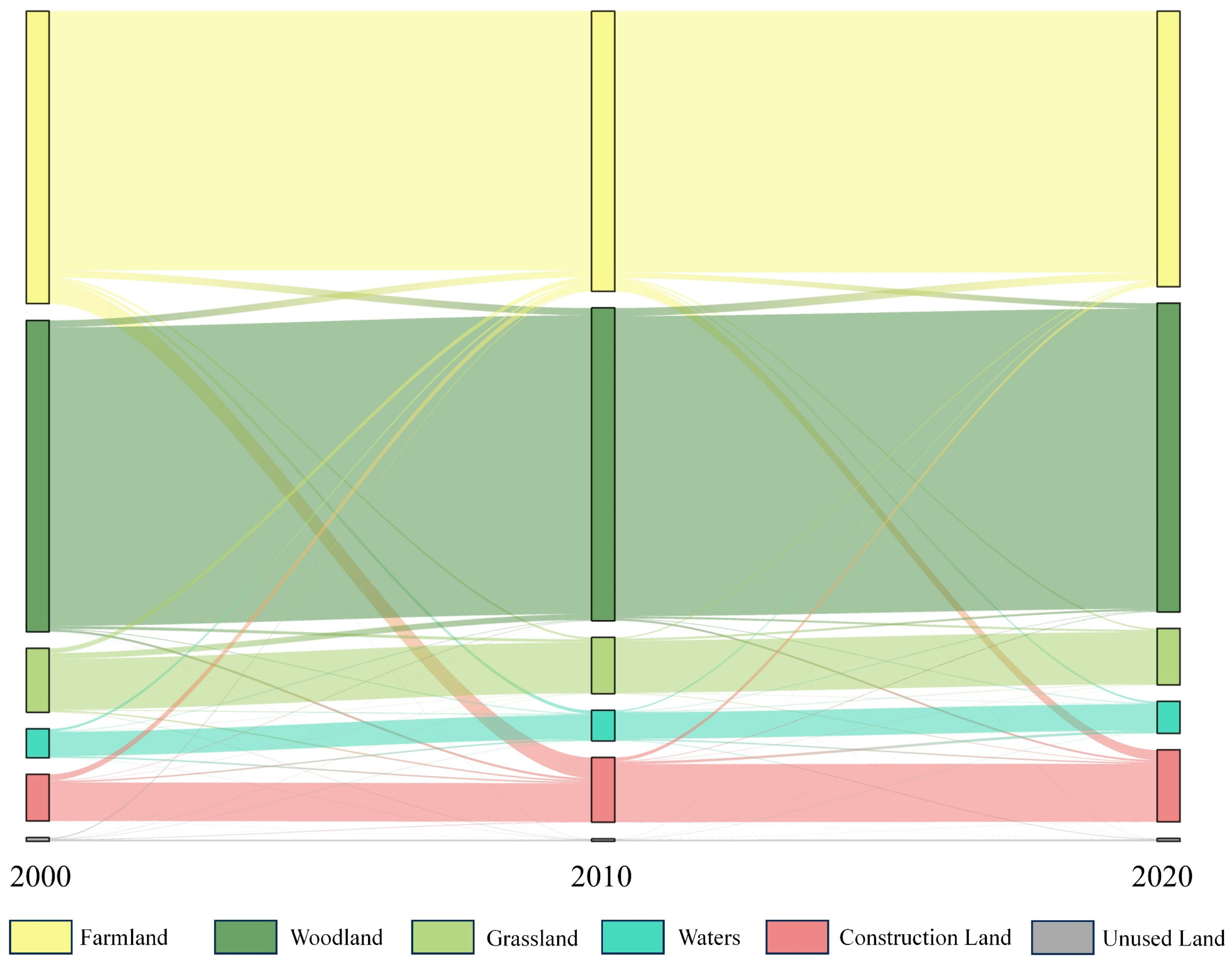

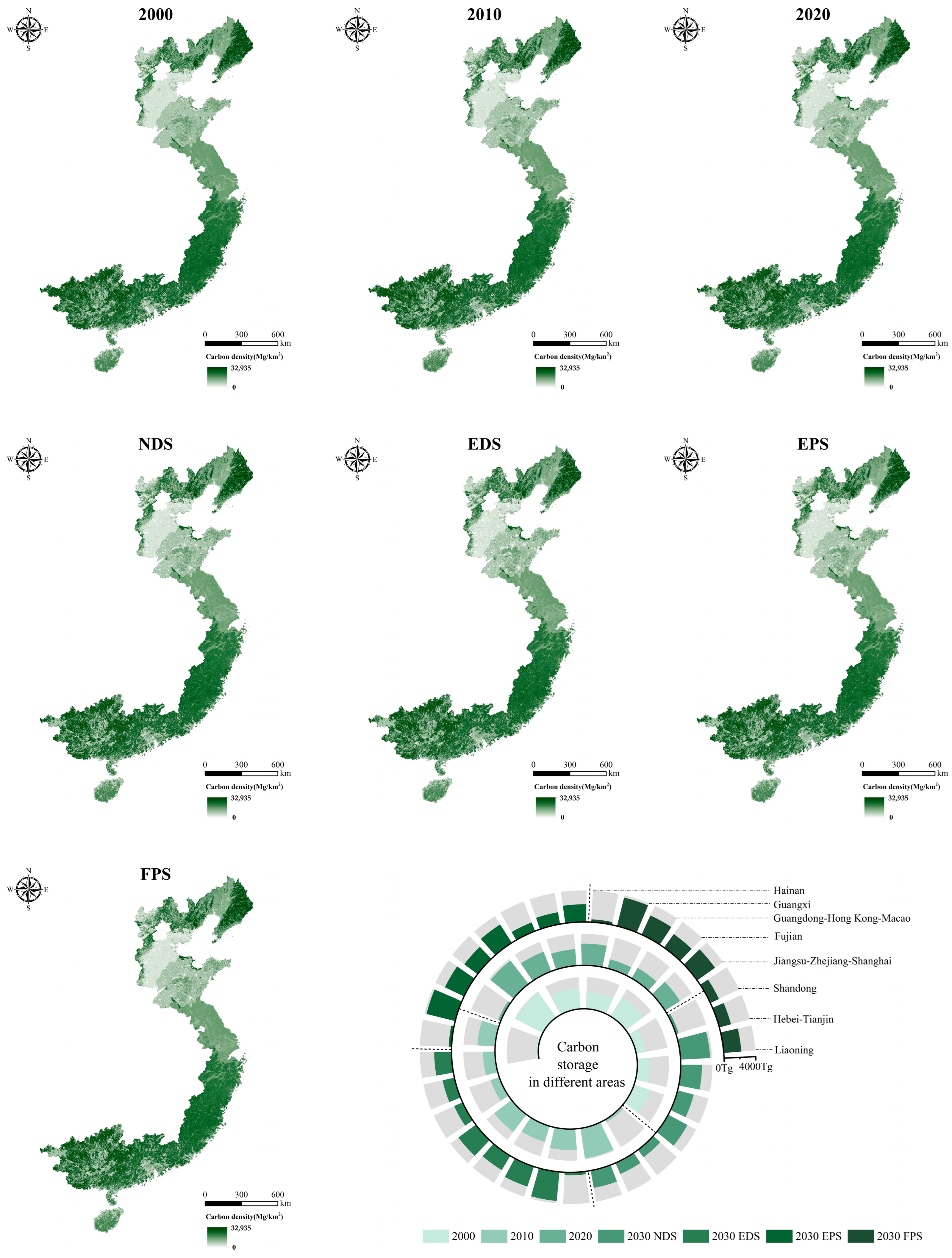
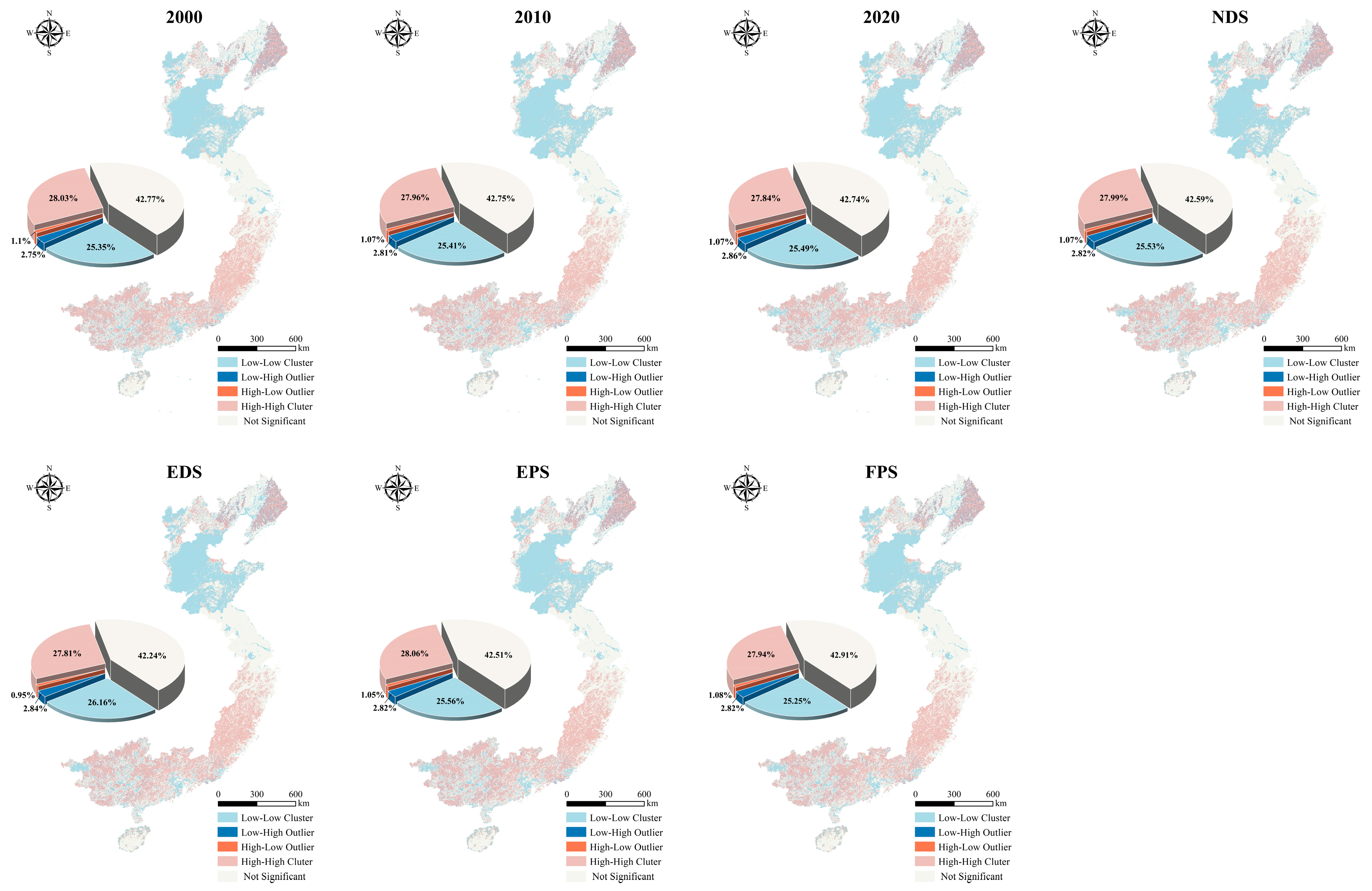
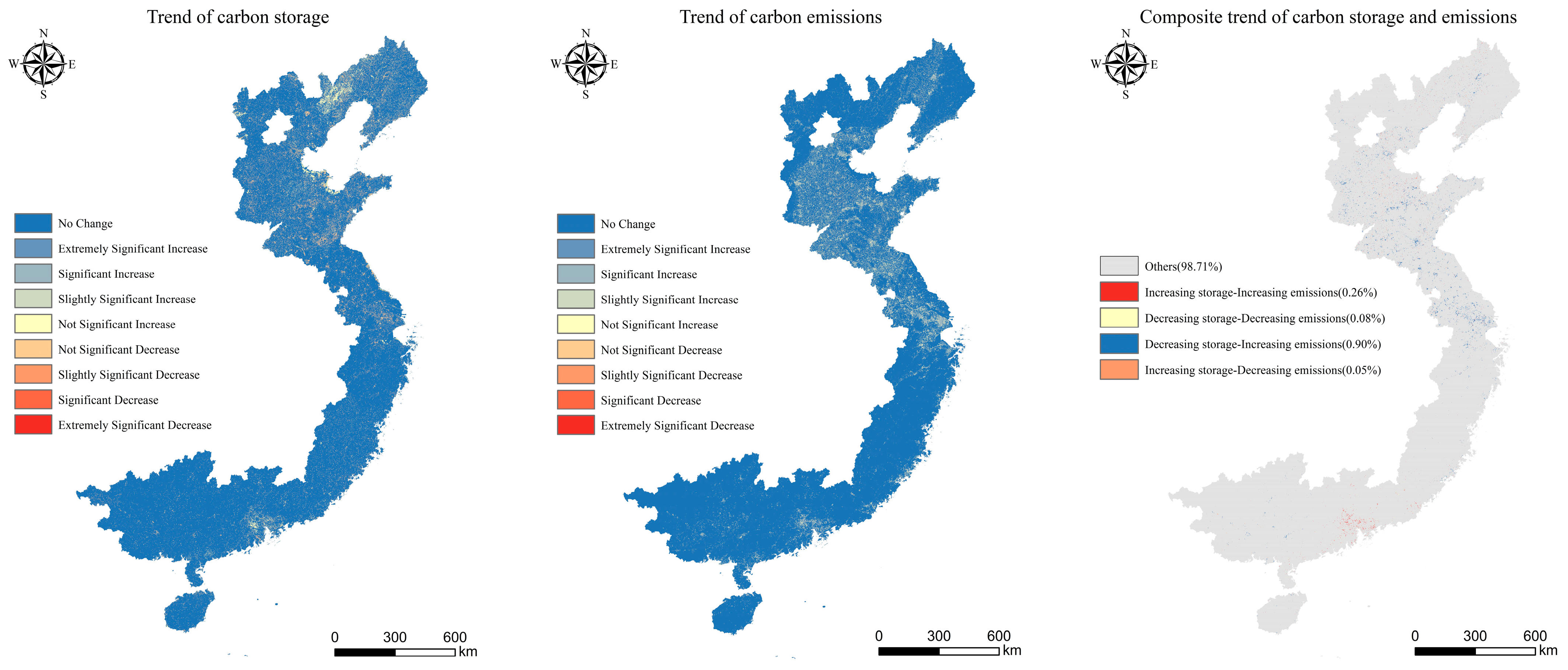
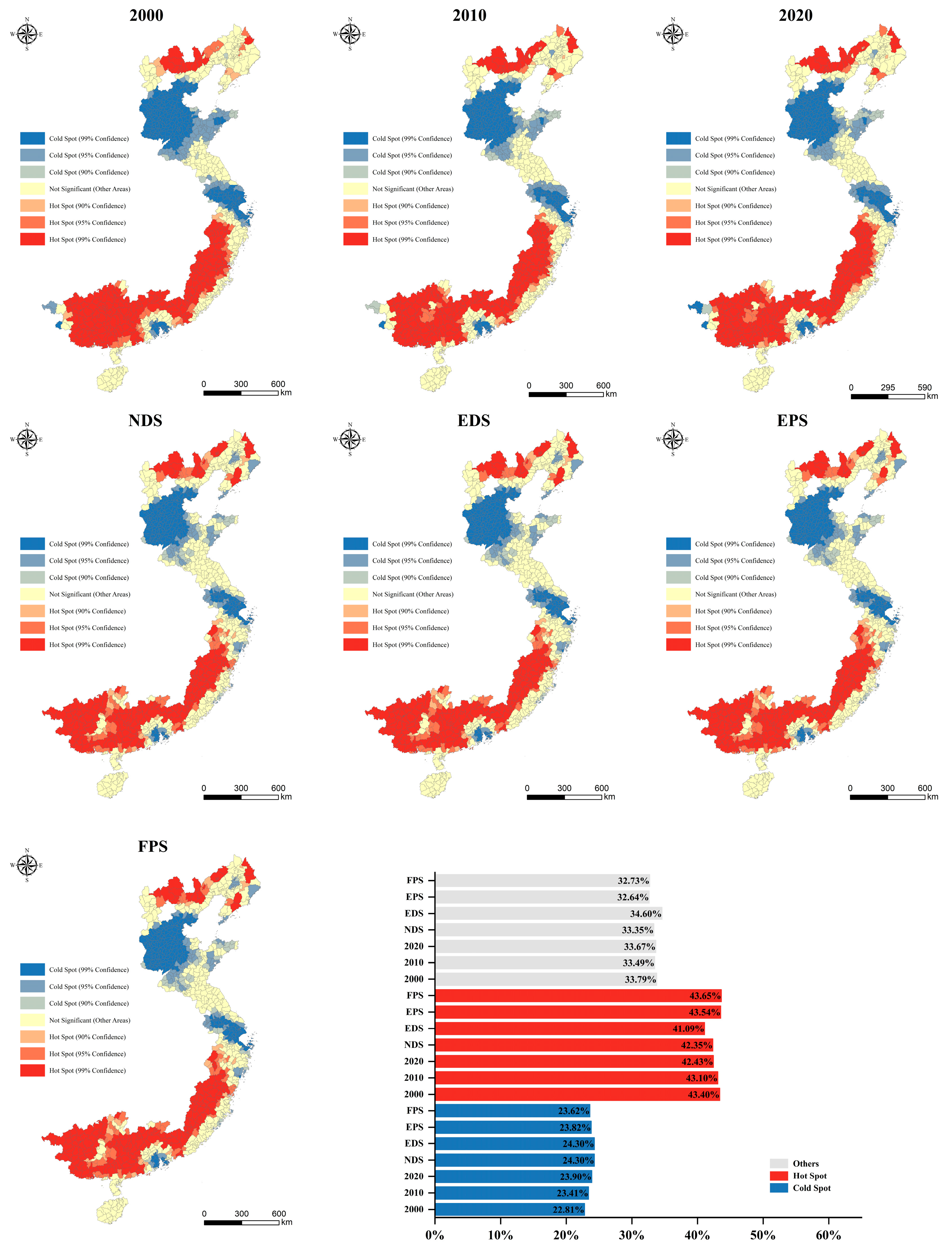
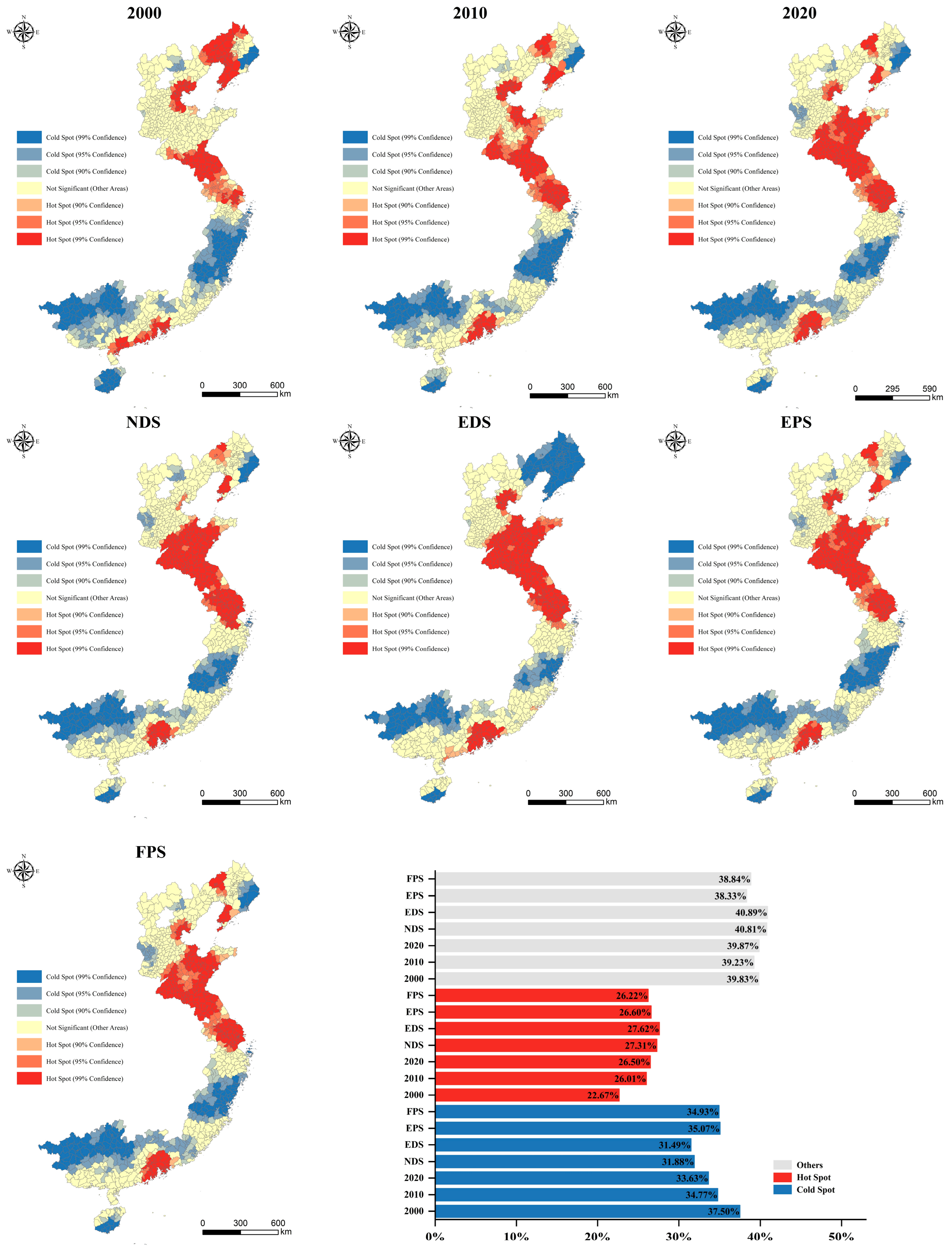
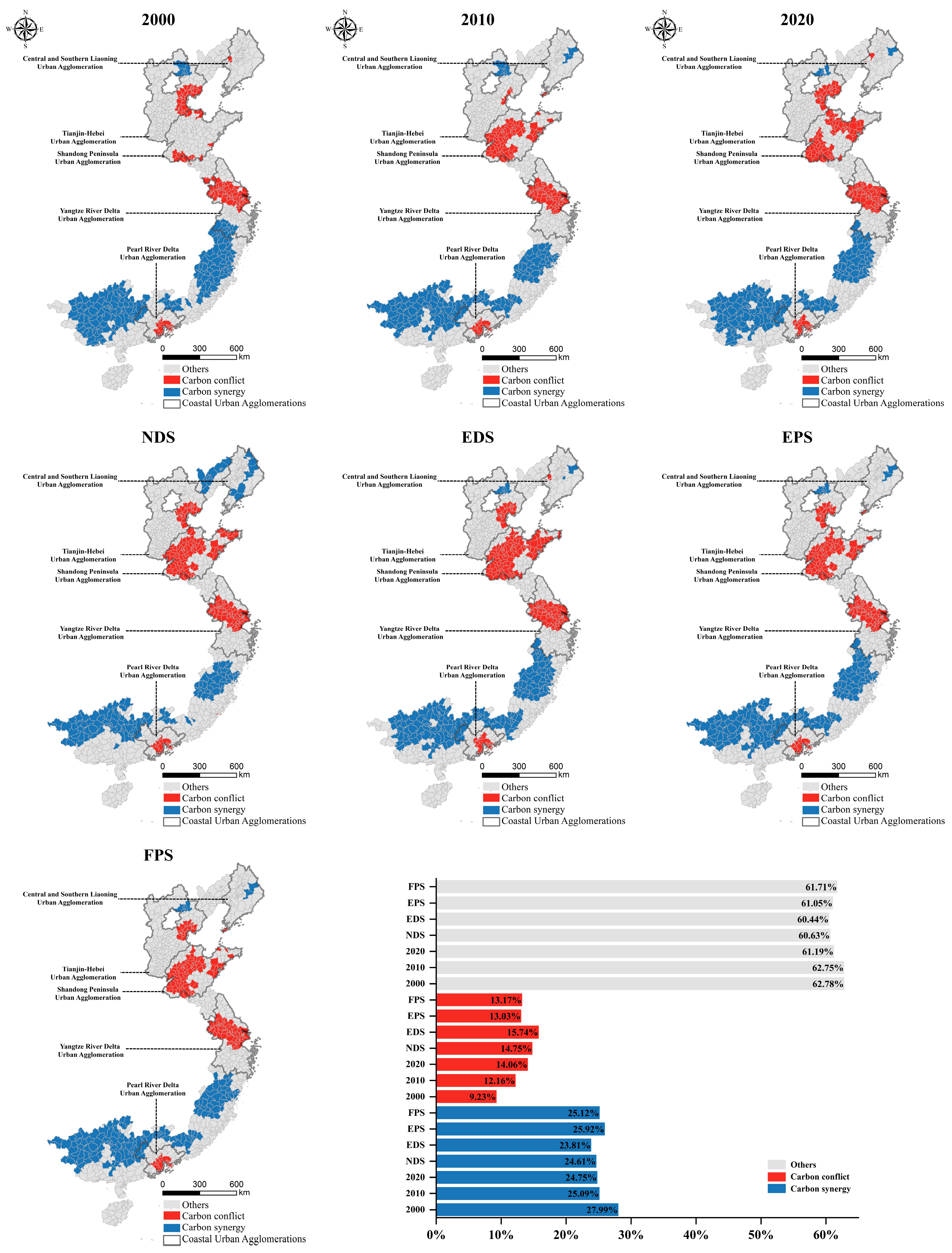
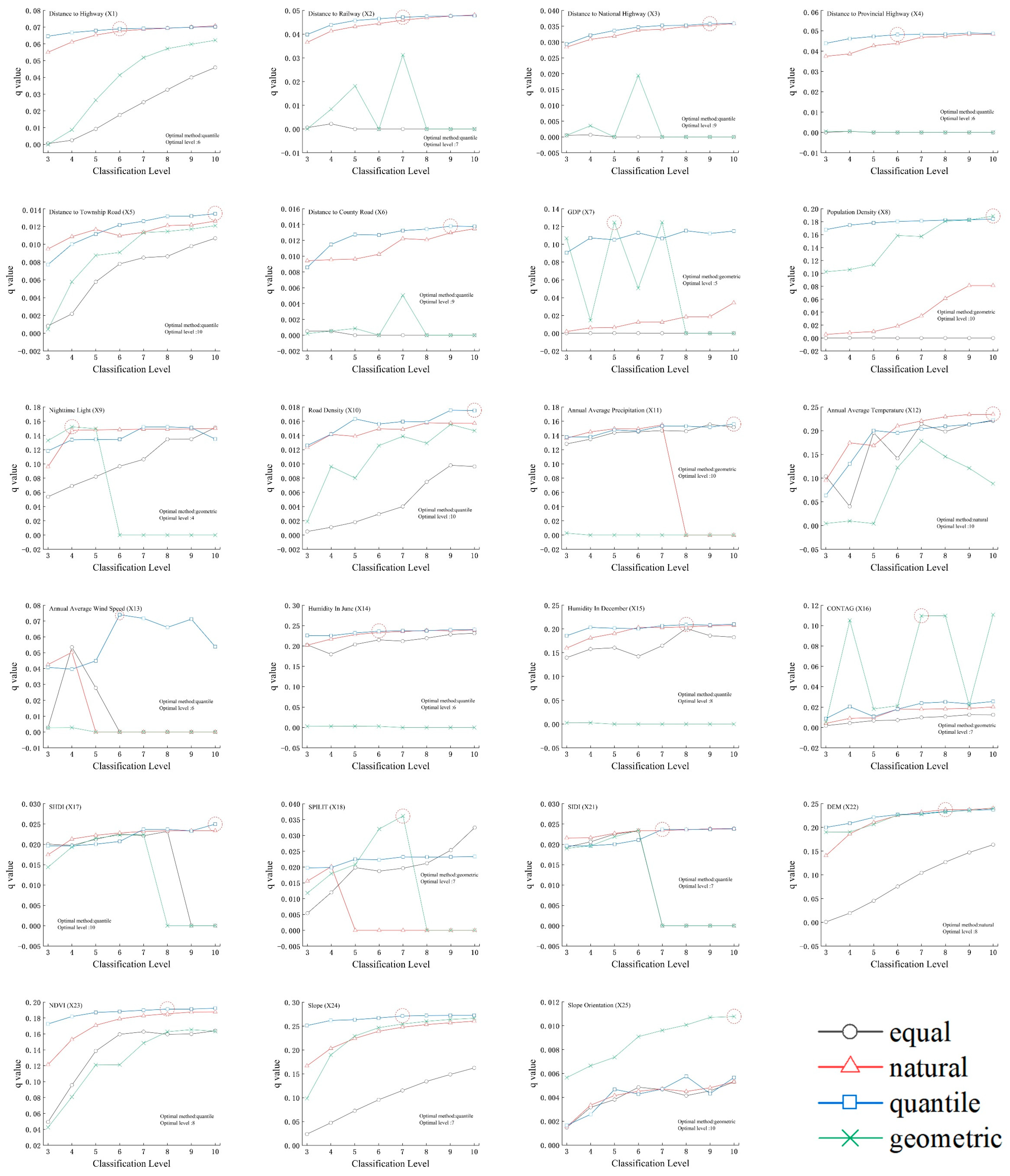
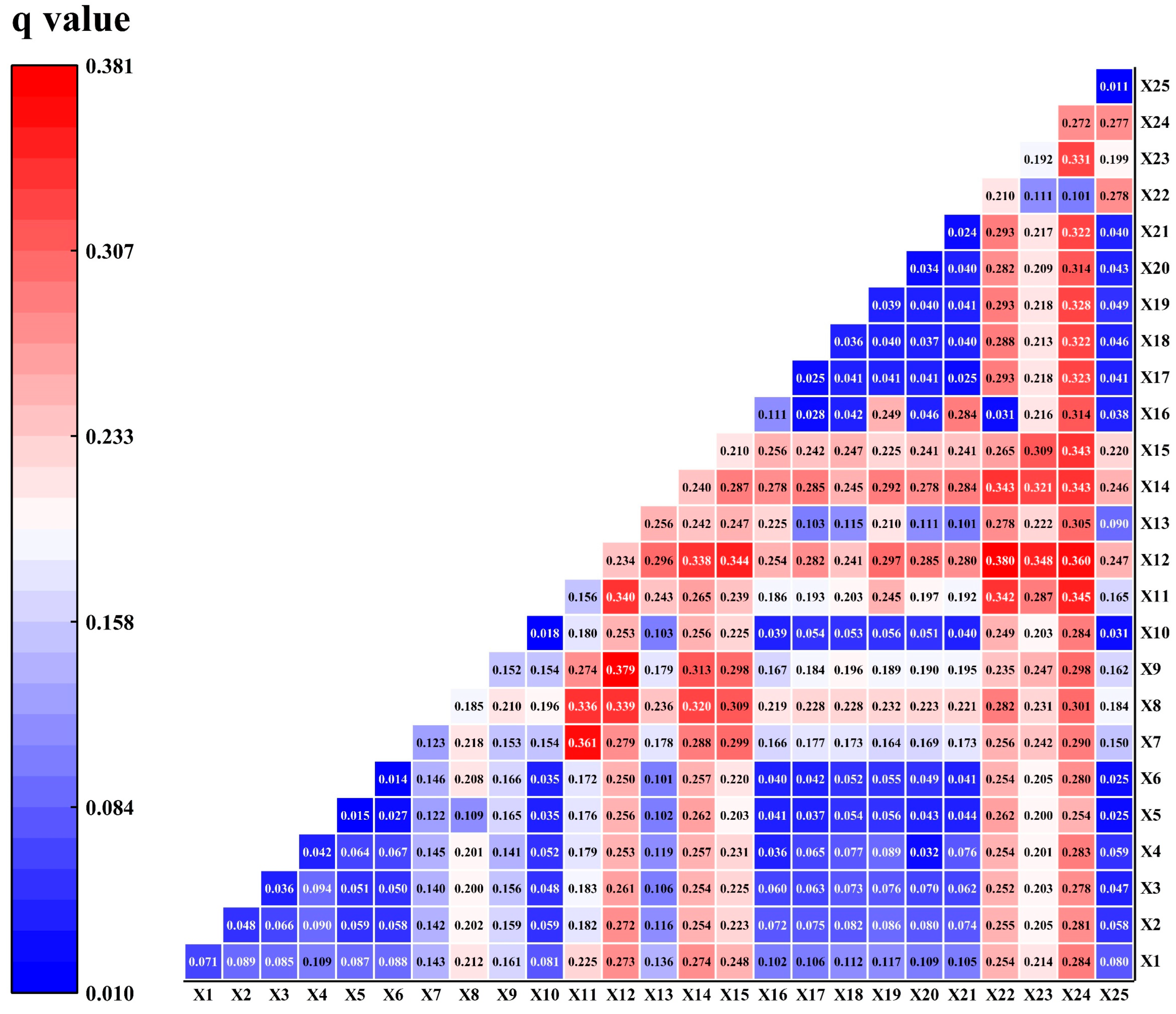
| Data Category | Data Description | Resolution | Data Source |
|---|---|---|---|
| Administrative boundary | City administrative boundary data and ecological conservation zone data | Shapefile | Chinese Academy of Sciences Resource and Environmental Science Data Center (https://www.resdc.cn, accessed on 1 August 2024) |
| Land-use/cover data | 2000–2020 Land-use/cover type | ||
| Accessibility factors | Distance to highway (X1) | Shapefile | OpenStreetMap (http://www.openstreetmap.org, accessed on 1 August 2024). Calculated based on road network |
| Distance to railway (X2) | |||
| Distance to national highway (X3) | |||
| Distance to provincial highway (X4) | |||
| Distance to township road (X5) | |||
| Distance to county road (X6) | |||
| Socioeconomic factors | Unit gross domestic product (GDP, X7) | 1 km | Chinese Academy of Sciences Resource and Environmental Science Data Center (https://www.resdc.cn, accessed on 1 August 2024) |
| Population density (POP, X8) | |||
| Nighttime light index (X9) | 1 km | (https://dataverse.harvard.edu/dataset.xhtml?persistentId=doi:10.7910/DVN/GIYGJU, accessed on 1 August 2024) | |
| Road density (X10) | 1 km | Calculated based on road network data | |
| Climate factors | Annual average precipitation (X11) | 1 km | National Earth System Science Data Center (http://www.geodata.cn/, accessed on 1 August 2024) |
| Annual average temperature (X12) | |||
| Annual average wind speed (X13) | |||
| Humidity in June (X14) | |||
| Humidity in December (X15) | |||
| Landscape factors | CONTAG (X16) | 1 km | Calculated by the Fragstats4.2 software based on land-use/cover data |
| SHDI (X17) | |||
| SPILIT (X18) | |||
| LPI (X19) | |||
| PD (X20) | |||
| SIDI (X21) | |||
| Biophysical factors | Elevation (X22) | 1 km | Geospatial Data Cloud (https://www.gscloud.cn, accessed on 1 August 2024) |
| Normalized difference vegetation index (NDVI, X23) | |||
| Slope (X24) | 1 km | Calculated based on DEM data | |
| Slope orientation (X25) |
| Year | Carbon Storage (Tg) | |||||
|---|---|---|---|---|---|---|
| Aboveground | Belowground | Dead Organic | Soil Organic | Total | ||
| 2000 | 5235.36 | 1935.01 | 488.36 | 9043.44 | 16,702.17 | |
| 2005 | 5229.99 | 1922.20 | 485.90 | 9033.90 | 16,671.98 | |
| 2010 | 5244.62 | 1916.91 | 478.91 | 9010.37 | 16,650.81 | |
| 2015 | 5219.94 | 1898.95 | 465.90 | 8973.79 | 16,558.57 | |
| 2020 | 5176.62 | 1862.40 | 438.61 | 8946.16 | 16,423.78 | |
| 2030 | NDS | 5136.47 | 1865.90 | 439.46 | 8978.90 | 16,420.73 |
| EPS | 5164.86 | 1895.92 | 470.97 | 9002.80 | 16,534.55 | |
| EDS | 5107.86 | 1868.69 | 465.83 | 8962.97 | 16,405.35 | |
| FPS | 5152.86 | 1893.75 | 471.06 | 9016.13 | 16,533.80 | |
| Land-Use/Cover Type | 2000 | 2005 | 2010 | 2015 | 2020 | 2030 | |||
|---|---|---|---|---|---|---|---|---|---|
| NDS | EPS | EDS | FPS | ||||||
| Farmland | 25.91% | 25.47% | 24.59% | 24.41% | 24.28% | 22.07% | 21.67% | 22.00% | 22.73% |
| Woodland | 59.70% | 59.75% | 60.17% | 60.01% | 59.56% | 63.12% | 62.53% | 63.07% | 62.81% |
| Grassland | 7.95% | 7.77% | 7.10% | 7.10% | 7.15% | 7.18% | 7.24% | 7.16% | 7.15% |
| Waters | 2.54% | 2.59% | 2.81% | 2.83% | 3.04% | 3.15% | 3.28% | 3.12% | 3.02% |
| Construction Land | 3.71% | 4.23% | 5.17% | 5.48% | 5.80% | 4.40% | 5.21% | 4.57% | 4.20% |
| Unused Land | 0.20% | 0.19% | 0.16% | 0.17% | 0.17% | 0.08% | 0.08% | 0.09% | 0.09% |
Disclaimer/Publisher’s Note: The statements, opinions and data contained in all publications are solely those of the individual author(s) and contributor(s) and not of MDPI and/or the editor(s). MDPI and/or the editor(s) disclaim responsibility for any injury to people or property resulting from any ideas, methods, instructions or products referred to in the content. |
© 2025 by the authors. Licensee MDPI, Basel, Switzerland. This article is an open access article distributed under the terms and conditions of the Creative Commons Attribution (CC BY) license (https://creativecommons.org/licenses/by/4.0/).
Share and Cite
Li, C.; Huang, J.; Luo, Y.; Wang, J. Spatial Synergy Between Carbon Storage and Emissions in Coastal China: Insights from PLUS-InVEST and OPGD Models. Remote Sens. 2025, 17, 2859. https://doi.org/10.3390/rs17162859
Li C, Huang J, Luo Y, Wang J. Spatial Synergy Between Carbon Storage and Emissions in Coastal China: Insights from PLUS-InVEST and OPGD Models. Remote Sensing. 2025; 17(16):2859. https://doi.org/10.3390/rs17162859
Chicago/Turabian StyleLi, Chunlin, Jinhong Huang, Yibo Luo, and Junjie Wang. 2025. "Spatial Synergy Between Carbon Storage and Emissions in Coastal China: Insights from PLUS-InVEST and OPGD Models" Remote Sensing 17, no. 16: 2859. https://doi.org/10.3390/rs17162859
APA StyleLi, C., Huang, J., Luo, Y., & Wang, J. (2025). Spatial Synergy Between Carbon Storage and Emissions in Coastal China: Insights from PLUS-InVEST and OPGD Models. Remote Sensing, 17(16), 2859. https://doi.org/10.3390/rs17162859






